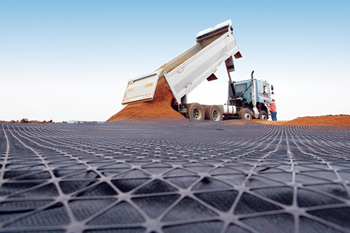 9 September 2010 – The £80 million A1073 replacement link between Spalding and Peterborough is being constructed over highly variable ground conditions in the Fens, helped by the mechanical stabilisation performance of Tensar International’s TriAx™ geogrids.
9 September 2010 – The £80 million A1073 replacement link between Spalding and Peterborough is being constructed over highly variable ground conditions in the Fens, helped by the mechanical stabilisation performance of Tensar International’s TriAx™ geogrids.
Use of 130,000 sq.m. Tensar TriAx™ to mechanically stabilise the sub-base resulted in minimal soil excavation and reduced plant requirements. The inclusion of locally won sand and gravel capping also reduced the environmental impact and lowered imported material costs.
“In many places the contractor would have been replacing at least 500mm of materials over considerable distances for the full length of the road,” comments says Lincolnshire County Council’s senior project leader Lee Rowley. “As the sections requiring amelioration were extensive, it was more economical to stabilise the fill layer above. By using TriAx™, we should also improve long term performance and reduce maintenance requirements at no greater cost.”
At 22km the new road is the UK’s longest project in 2009-2010, and will bypass the existing, hazardous narrow road which carries extensive local traffic. Originally salt marsh, the area was regularly inundated; current ground levels are between 1m and 2m above sea level, and the high water table and sinking ground still create flooding problems.
Detailed ground investigation, by the Lincolnshire County Laboratory, revealed 200-300mm of topsoil over around 1-2m of firm alluvial clay across much of the site, overlaying very soft clay and peat layers. However, in many locations, the firm clay crust is deficient or entirely missing, being replaced by loose sand or sandy silt, with additional pockets of loose peat and silt.
The road foundation and pavement structure is approximately 1.1m in thickness, and is designed to be constructed over the ground with as little topsoil removed as possible; the finished road level is 0.5m above existing ground level. Where the clay crust is thin and the base of the road reaches within 0.5m of the base of the crust, the Laboratory recommended removal of weak material with a California Bearing Ratio of less than 2, and replacement by granular fill.
“This would have meant that half a metre or more of material might have to be removed and, as the sections requiring amelioration were extensive, it was more economical to stabilise the fill layer above,” adds Lee Rowley.
The resulting design included removal of 150mm of topsoil, and introduction of a sub-base of 150-180mm of Type 1 imported granite aggregate fill, mechanically stabilised with Tensar TriAx™ and with a geotextile separation layer. In all, TriAx™ was used over around half the road length of the single carriageway road, as well as some hard shoulder areas. In areas prone to seasonal flooding, the sub-base thickness was increased to up to 235mm.
Scheduled for completion in summer 2010, the road will provide a much faster and straighter link while allowing local traffic to use the older road; there are seven connections between the two roads. The old A1073 road needed frequent maintenance, which was another source of frustration for motorists which should be alleviated by the modern construction methods.
DETAILS
Client: Lincolnshire County Council, supported by a £70 million grant from the Department of Transport
Design support: Jacobs (LCC professional services partner)
For further information on Tensar TriAx™ and pavement sub-base mechanical stabilisation solutions, please visit www.tensar.co.uk.
PRESS CONTACT
Paul Myerscough
IAS B2B Marketing
+44 01625 578578
Fax: +44 01625 578579
paul.myerscough@iasb2b.com











